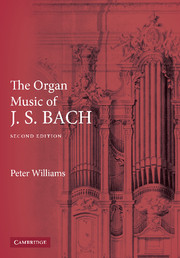Book contents
- Frontmatter
- Contents
- Preface
- List of abbreviations
- BWV 131a Fugue in G minor
- BWV 525–530 Six Sonatas
- Preludes and Fugues (Praeludia) BWV 531–552
- Eight Short Preludes and Fugues BWV 553–560
- Miscellaneous pieces BWV 561–591
- Concertos BWV 592–596
- BWV 597 and 598
- Orgelbüchlein BWV 599–644
- Schübler Chorales BWV 645–650
- Chorales formerly called ‘The Eighteen’ BWV 651–668
- Chorales from Clavierübung III BWV 669–689
- Chorales formerly called ‘The Kirnberger Collection’ BWV 690–713
- Miscellaneous chorales BWV 714–765
- Chorale variations (partitas) BWV 766–771
- BWV 790
- Four Duets from Clavierübung III BWV 802–805
- BWV 943, BWV 957, BWV 1027a and 1039a, BWV 1029.iii, BWV 1079.ii, BWV 1085
- Chorales now called The Neumeister Collection BWV 1090–1120
- Further works, in part of uncertain origin
- Calendar
- Glossary
- Bibliography
- Index of names
- Index of BWV works cited
BWV 131a Fugue in G minor
Copies via J. C. Kittel (P 320 etc.)
Published online by Cambridge University Press: 22 September 2009
- Frontmatter
- Contents
- Preface
- List of abbreviations
- BWV 131a Fugue in G minor
- BWV 525–530 Six Sonatas
- Preludes and Fugues (Praeludia) BWV 531–552
- Eight Short Preludes and Fugues BWV 553–560
- Miscellaneous pieces BWV 561–591
- Concertos BWV 592–596
- BWV 597 and 598
- Orgelbüchlein BWV 599–644
- Schübler Chorales BWV 645–650
- Chorales formerly called ‘The Eighteen’ BWV 651–668
- Chorales from Clavierübung III BWV 669–689
- Chorales formerly called ‘The Kirnberger Collection’ BWV 690–713
- Miscellaneous chorales BWV 714–765
- Chorale variations (partitas) BWV 766–771
- BWV 790
- Four Duets from Clavierübung III BWV 802–805
- BWV 943, BWV 957, BWV 1027a and 1039a, BWV 1029.iii, BWV 1079.ii, BWV 1085
- Chorales now called The Neumeister Collection BWV 1090–1120
- Further works, in part of uncertain origin
- Calendar
- Glossary
- Bibliography
- Index of names
- Index of BWV works cited
Summary
This is a transcription of the last forty-five bars of the final chorus of Cantata 131 (1707), whose opening and closing movements are, unusually, a prelude and fugue, the latter a permutation fugue of three subjects (Example 1).This conforms to the tradition of choral permutation fugues (Krüger1970 p. 11), as in other early works: Cantata 196, the Capriccio in B♭ major. Perhaps the model is Reinken'ssonatas and through them ultimately Frescobaldi's Fiori musicali. Unlike the Passacaglia fugue, BWV 131a has nointerludes, and its many tonic cadences are typical of such fugues. After Frescobaldi, one line in a permutation fugue was often chromatic, with influentialexamples in Kuhnau's Clavierübung II (Leipzig, 1692) and also Pachelbel's Magnificat primi toni, v. 19 (1701–5?), which has achromatic fourth subject and countersubject much like b. 3 of Example 1.
J. S. Bach is usually thought not to be the arranger (Spitta I p. 451), and as with BWV 539, details make it unlikely to be authentic: the sources (many, but from a common route), certain unidiomatic moments, omission or alteration offugal parts, and little in common with the authentic early fugues BWV 531, 549a. Lines impossible for two hands are omitted and the basssimplified. The succinct ending, though also vocal, need not be Bach's (as Bartels 2001 suggests), but could be the work of an arranger such as Kittel. Thecantata's ending was surely the original, i.e. with a gradual buildup from two to five parts.
- Type
- Chapter
- Information
- The Organ Music of J. S. Bach , pp. 1Publisher: Cambridge University PressPrint publication year: 2003



